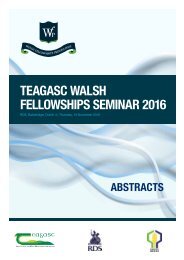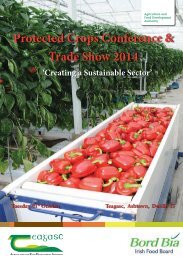Driving Farm Innovation through Knowledge Transfer
1S93ppX
1S93ppX
You also want an ePaper? Increase the reach of your titles
YUMPU automatically turns print PDFs into web optimized ePapers that Google loves.
Number of Dairy <strong>Farm</strong>ers<br />
Using the innovation-decision process to<br />
understand reasons for the low uptake of grass<br />
measuring technology on dairy farms<br />
P. Newman 1 , M. Moore 1 & D. O’Connor 2<br />
1<br />
Teagasc Headquarters Oak Park, Co. Carlow<br />
2<br />
UCD, Belfield, Dublin 4<br />
Background<br />
Grazed grass is the cheapest feed source for milk production in Ireland (Teagasc, 2011).<br />
Ireland’s competitive advantage is the potential of its pastures to grow up to 16 t of grass<br />
DM/ha (O’Donovan et al., 2010). An increase in grass utilisation by 1 t/ha can increase net<br />
profit by €161/ha (Teagasc, 2015). Growth rates are seasonal with considerable variation<br />
observed between regions (Ramsbottom et al., 2015). Computer programmes are available<br />
to farmers as a grassland management decision support tool. However, only a minority of<br />
farmers currently use new grassland management technologies.<br />
Aim<br />
The aim of the research is to identify dairy farmers stage within the adoption process and to assess their<br />
reasons for adoption or non-adoption of grass measuring technology.<br />
Objectives<br />
Methodology<br />
• Collecting a survey of Teagasc dairy farmers in<br />
county Carlow to identify their stage within the<br />
innovation-decision process.<br />
• Evaluate their reasons for adoption or non-adoption<br />
of grass measuring technology.<br />
• Identify and compare key characteristics associated<br />
with each stage of the innovation-decision process.<br />
• Categorisation of non-adopters and development of<br />
more targeted and effective <strong>Knowledge</strong> <strong>Transfer</strong><br />
initiatives<br />
Sources of Data<br />
Population: 121 (specialist dairy farms)<br />
Sample size: 92 (specialist dairy farms)<br />
Location: County Carlow<br />
Methods: Mixed methods (quantitative and<br />
qualitative)<br />
Methods of Data Collection<br />
• The use of a telephone survey to collect data<br />
for the study<br />
• Interview Teagasc and Industry experts<br />
Finding to Date<br />
Distribution of Respondents in the Stages of the <strong>Innovation</strong>-Decision Process<br />
Decision Stage<br />
60<br />
24%<br />
50<br />
50 50 50 50<br />
37%<br />
40<br />
45<br />
30<br />
38 38<br />
Continued Adoption<br />
Discontinuance<br />
Later Adoption<br />
Continued Rejection<br />
20<br />
18%<br />
10<br />
<strong>Farm</strong>ers Surveyed<br />
<strong>Farm</strong>ers Progression<br />
9<br />
0<br />
<strong>Knowledge</strong> Persuasion Decision Implementation<br />
21%<br />
Stages<br />
Conclusions<br />
• To increase the adoption rate of grass measuring technology and for it to be successfully implemented on dairy<br />
farms as a grassland management decision support tool, more support must be provided to farmers.<br />
• The formation of grassland discussion groups focused entirely on grassland management is one method to<br />
improve farmers skills and offer continued support.<br />
This project is funded by Teagasc <strong>through</strong> its Walsh Fellowship Scheme




